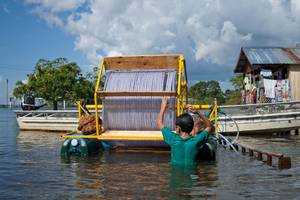A Master project within Industrial design at LTH by Johanna Bengtsson.
After a month long research trip to the Amazon river I decided to work with water harvesting for the most economically poor people in the region.
From my keywords, local production, low running cost and renewable power sources, I refined the water driven water pump.
I had the opportunity to work in the Amazon (Brazil) with the flood plain community Nossa Senhora das Graças.
During a month long stay I observed the daily life of the people. A life where the inhabitants have shaped their daily routines after the rising and dropping water level of the Solimões river (a part of the Amazon river). I identified a need of harvesting water during the low water season, when the river in some areas draws back up to one kilometer.
Today people walk far over heavy terrain under a frying sun or uses gasoline powered boat motors to pump up the river water.
During my master project within Industrial design I decided to focus on how to transport the river water up to households in a low cost, silent and maintenance free way by using the velocity of the river.
The main goal was to transform the ancient coil pump to fit the unique situation in the Solimões river and to make it producible for the local people.
The benefit of using a spiral pump is that it from few rotations can build up a high pressure to pump the water. By connecting it to a water wheel it can be powered by the velocity from the river.
The pump handles water that contains sediments very well and has few critical mechanical parts that can fail. It has an easy and sturdy construction, similar to the construction of a bike. This makes it easy to produce on sight of the people with local materials and can be maintained and repaired by the inhabitants.
The design part of the project was to modify the coil pump which is mostly used in small, private and stable rivers to fit the big Solemões river with it’s changing water level, vast animal life, thick vegetation with floating obstacles and heavy boat traffic. Connections along the tube from the pump to the house makes it possible to disconnect and move the pump closer to the house then the water level is rising. This will protect it from damage from boat traffic. A lamp will signal to boats during night to prevent collisions. A V-shaped protection in front of the pump will protect the construction from hits from floating obstacles and vegetation.
The construction of the pump is developed so that it can be produced, maintained and repaired with simple tools and local material in the villages.
The concept and first prototyping phase of the project took part back home in Lund (Sweden). This prototype was exhibited at Lund University in June.
The second prototype was produced on site in Manaus with local materials, a grinding machine, a handsaw and a stick-welding machine. The challenge was to find a space to work at, with the material bought it took three to four days to make the pump. The pump was transported out to the village Nossa Senhora das Graças and installed.
The pump is still in the village.
The project was presented at a workshop at Lund University with selected actors (e.g. schools, businesses, NGOs, aid organizations) that are involved in the design and development of products and services at the Base of the Pyramid.
In the near future I will join Ankarstiftelsen on a trip to Colombia and install a pump together with their water cleaning system in one of the villages where they are running their projects.
For more information
